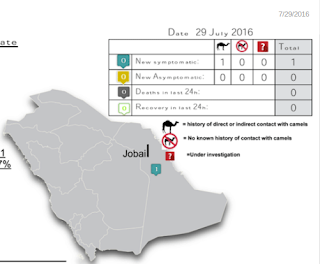#11,596
After a quick start in May and June, the tropical Atlantic quieted down for July, and is just now starting to show some life. While neither of the two disturbances shown in the map above have a closed circulation, both have some potential to develop.
This morning's NOAA tropical forecast gives invest 97L - about to enter the Eastern Caribbean - a 70% chance of becoming a tropical cyclone over the next 5 days.
TROPICAL WEATHER OUTLOOK
NWS NATIONAL HURRICANE CENTER MIAMI FL
200 AM EDT SUN JUL 31 2016
For the North Atlantic...Caribbean Sea and the Gulf of Mexico:
1. A fast-moving tropical wave is nearing the Lesser Antilles. Although showers and thunderstorms are fairly well-organized, there are currently no signs a closed surface circulation. However, this system has the potential for some slow development during the next couple of days, but the best chance for tropical cyclone formation is likely to be by the early to middle part of next week when the wave reaches the western Caribbean Sea. This system is expected to bring locally heavy rains and gusty winds to portions of the Lesser Antilles, Virgin Islands, and Puerto Rico today. Shower and thunderstorm activity should spread westward across the eastern Caribbean Sea and Hispaniola by tonight and on Monday. Interests in these areas should monitor the progress of this disturbance.
* Formation chance through 48 hours...medium...40 percent
* Formation chance through 5 days...high...70 percent
2. Shower and thunderstorm activity associated with a tropical wave and a low pressure system centered about 650 miles west-southwest of the Cabo Verde islands has changed little in organization. This system is moving westward at 10 to 15 mph, and development, if any, should be slow to occur due to unfavorable upper-level winds.
* Formation chance through 48 hours...low...10 percent
* Formation chance through 5 days...low...10 percent
Long range models (which are always subject to change) take first system into the Western Caribbean, and possibly into the Gulf of Mexico, by the middle of next week.
We'll take a closer look at August's tropical climatology later in the week, but suffice to say that August, September, and early October mark the busiest part of the hurricane season.
While it isn't at all clear yet whether either of these budding systems will pose a threat to the U.S. mainland, this is the time of year to get, and stay, prepared.
So, if you haven’t already downloaded the updated Tropical Cyclone Preparedness Guide, now would be an excellent time to do so. You'll find additional preparedness information in my Hurricane Preparedness 2016 post from last May.
When it comes to getting the latest information on hurricanes, your first stop should always be the National Hurricane Center in Miami, Florida. These are the real experts, and the only ones you should rely on to track and forecast the storm.
And if you are on Twitter, you'll want to follow @FEMA, @CraigatFEMA, @NHC_Atlantic, @NHC_Pacific and @ReadyGov.
And a reminder, throughout the entire month of September FEMA, READY.GOV, state and local Emergency agencies, and grassroots coalition members will be promoting National Preparedness Month through community events, drills, and exercises and blogs like mine to encourage Americans to become better prepared to deal with all types of threats.

















